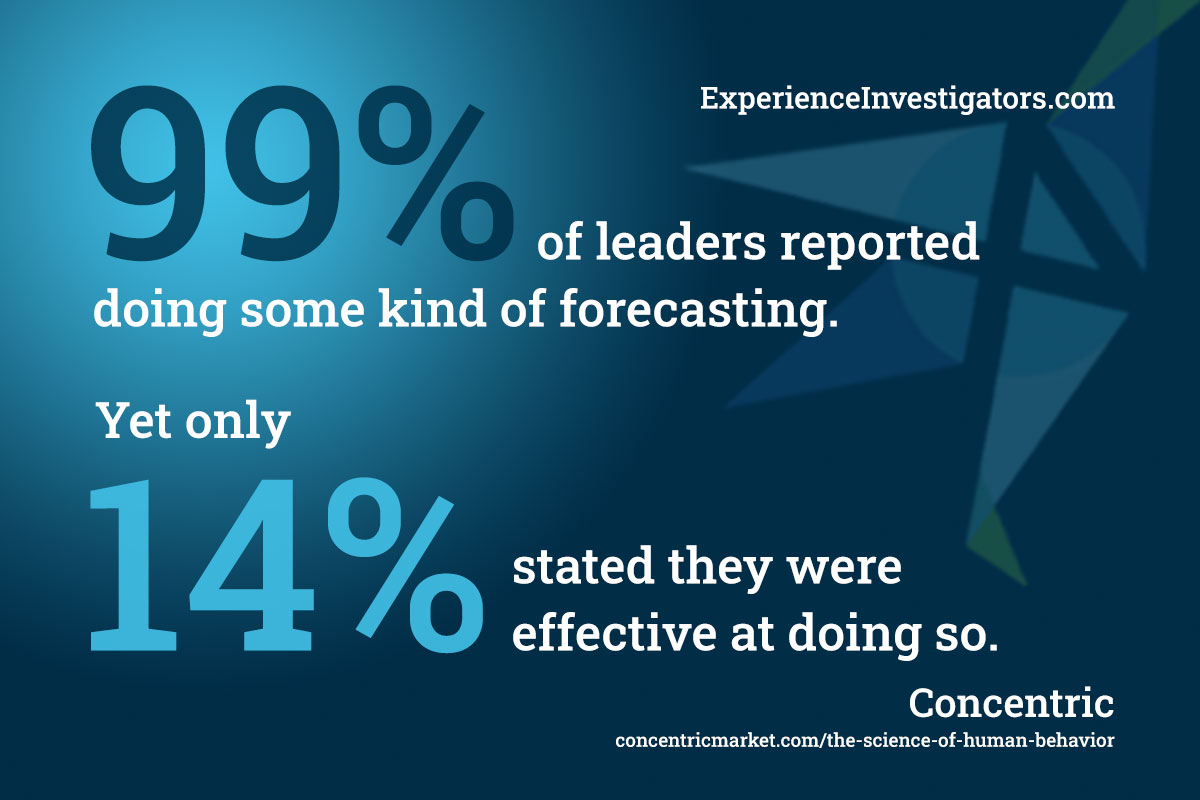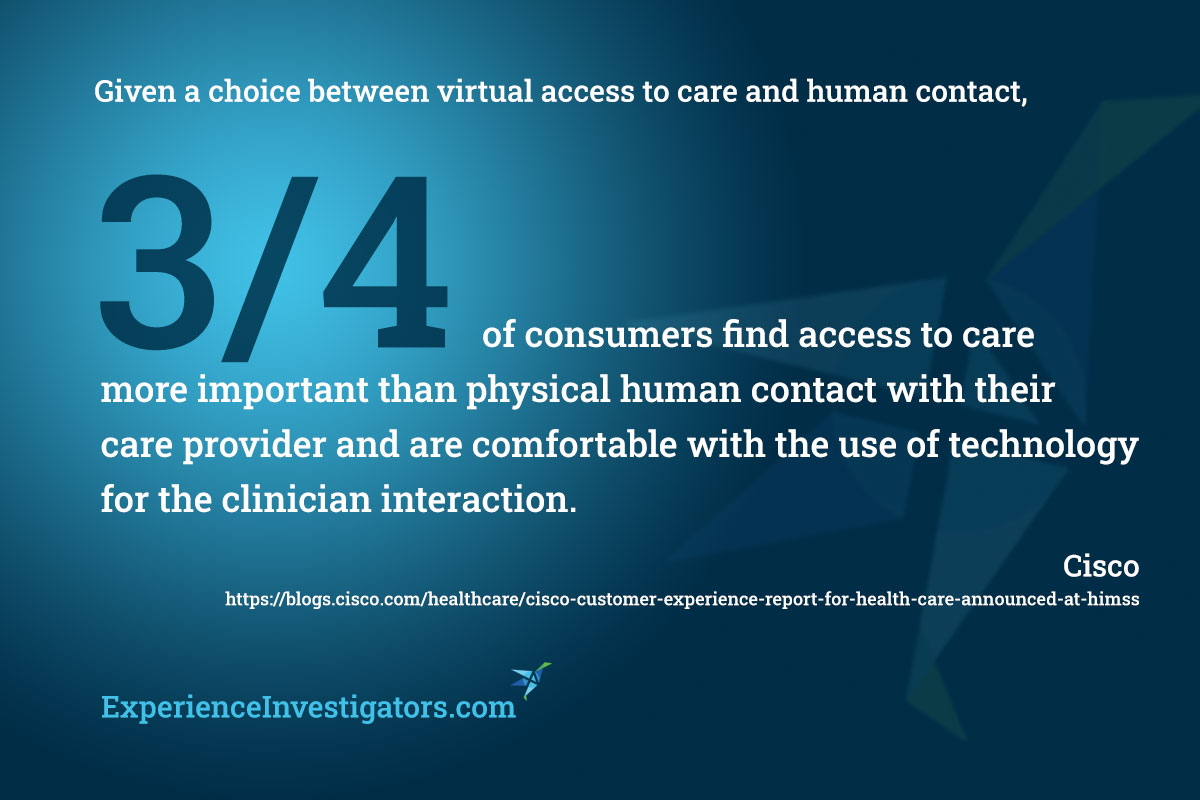Human behavior is notoriously difficult to predict.
Sophisticated modeling and massive data analysis can help, but these are typically based on past behavior. Past behavior might be helpful for predicting future successes, but what if the context or the entire environment changes from the past to the future?
In one study by Concentric, 99% of leaders reported doing some kind of forecasting. Yet only 14% stated they were effective at doing so.

It’s like the secret everyone knows – predicting the future is HARD.
Many organizations are benefiting from leveraging machine learning and artificial intelligence tools to isolate data points that can help predict next actions and future customer desired outcomes. But like many analysis tools, this methodology relies on good data, and many organizations are still playing catch up on getting those inputs right.
What can a business leader do to look ahead and predict future customer behavior?
Leaders of all kinds are being asked to “do better with customer experience” without much else. There is no data, there is no defined goal, and in some cases, there is no shared understanding of what customer experience is.
If you need to start from scratch, get your foundations right:
Almost without exception, most leaders tell me their industry is “unique.”
But there are absolutely trends you can apply to almost every industry.
A big trend for the future that I see is a focus on health and safety for customer experiences. It might be easy to dismiss that if you are in a business that serves other businesses instead of individual consumers.
If the B2B company is ever planning on inviting customers to their locations again, or ship products, or host a customer event…then those same concerns apply.
Look for the trends and then plan around them. Don’t ignore something because it doesn’t apply to your industry, because eventually it will!
People relocated from cities to suburbs during the pandemic months. They realized remote work allowed for this flexibility and moved their entire lives to accommodate more space and outdoor living.
What does that mean for your customer experience? It could mean a lot regarding store locations, delivery expectations, and even what product selection to offer.
Too often, I see leaders struggle with predictions because they create a universe where the customer has one goal – to use the company’s product. That’s not how people work, and the more you can truly pay attention to their overall environment, the more successful you’ll be in finding and acting on those customer clues.
Now what?
Now that you have an idea of what lies ahead, what can you do with these insights?
Who is the customer in one year or five? What are their needs and expectations? How can your customer journey support them and adapt accordingly?
This exercise is a great way to predict what you need to change to be there for the changing customer journey.
Once you identify what customers will prioritize about the customer journey in the future, look at the current journey for pain points that could get worse.
For example, knowing that more customers are now comfortable with using their mobile device to get information while they’re shopping in-person could mean friction if stores have slow wifi connections. Consider how a customer will use their device in-store and build up the environment to support that new behavior.
Related Reading: Customer Journey Mapping: Real-World Examples & Use Cases
Employees have great ideas and often see customer expectations changing in real time. They need a place to put these observations and ideas. Visibility around these submissions also creates collaboration for future innovation and ideas.
Contact center agents, for example, hear about frustrations caused by comparisons to the competition. Customers complain about wait times, for example, and say things like “even my car mechanic has a mobile update system now – why do I have to wait on hold?” That’s a changing and important future expectation to design around, but agents often are discouraged from recording those observations.
Keeping your finger on the pulse of change means looking ahead, and it means getting the support and leadership buy-in you need to act on it.
Several years ago, Cisco released a report about what healthcare providers and consumers want in healthcare. One of the findings that stood out to me was the idea that virtual doctor visits are perfectly acceptable to many of us.
The study found that while consumers still depend heavily on in person medical treatments, given a choice between virtual access to care and human contact, three quarters of consumers find access to care more important than physical human contact with their care provider and are comfortable with the use of technology for the clinician interaction.

I read this in 2013 and thought – doesn’t this apply to most customers?
Everyone is living more frenzied and complicated lives than ever before. While technology gives us access, it also keeps us tethered to jobs and obligations like never before.
Convenience continues to be a top-ranking driver for customer behavior and loyalty. Healthcare is no different. Why NOT offer video doctor visits for care that can be provided that way?
Just think of how many healthcare providers were still not prepared for the surge in video doctor visits in 2020! They were scrambling to set up the basic video visit and many still required patients to call the office to schedule those appointments.
They ignored the clues. Customers have been asking for this type of service for nearly a decade. But it’s easier to just keep doing what’s always been done.
Inertia is a powerful force. It can be easy to just let things happen the way they always have.
Leaders look ahead and consider the clues. Then, most importantly, they act.
 Jeannie is an award-winning customer experience expert, international keynote speaker, and sought-after business coach who is trailblazing the movement from “Reactive Customer Service” to “Proactive Customer and Employee Experience.” More than 500,000 people have learned from her CX courses on LinkedIn Learning, and her insights have been featured in Forbes, The Chicago Tribune, The Wall Street Journal and NPR.
Get Jeannie’s insights in your inbox each week by subscribing to The Weekly Win and follow her on LinkedIn, Instagram and YouTube.
Jeannie is an award-winning customer experience expert, international keynote speaker, and sought-after business coach who is trailblazing the movement from “Reactive Customer Service” to “Proactive Customer and Employee Experience.” More than 500,000 people have learned from her CX courses on LinkedIn Learning, and her insights have been featured in Forbes, The Chicago Tribune, The Wall Street Journal and NPR.
Get Jeannie’s insights in your inbox each week by subscribing to The Weekly Win and follow her on LinkedIn, Instagram and YouTube.